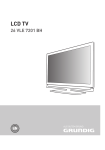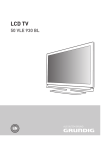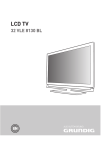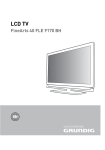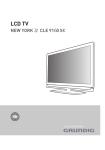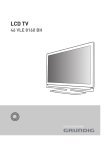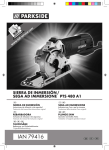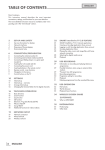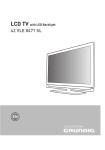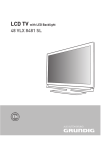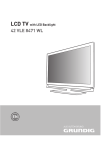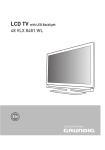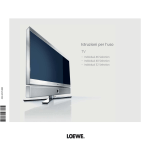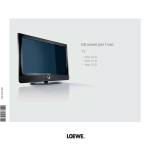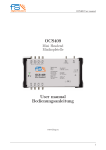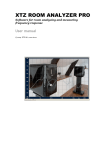Download 2 CONTENTS-------------------------------------------------------------
Transcript
ENGLISH CONTENTS------------------------------------------------------------------------------------------------------------------------------------Dear Customers, This instruction manual describes the most important connections, settings, and functions for your new television. The more detailed instruction manual is available under www.grundig.com in the "Downloads" section. 3 4 5 5 6 SETUP AND SAFETY Notes on still images Service information for dealers Environmental note Licence 19 3D FUNCTION 19 Important information about the 3D function 19 Preparing the 3D function 20 3D Settings 7 7 7 8 8 8 8 CONNECTION AND PREPARATION Connecting the antenna (socket A) Connecting external data media (socket B) Connecting a BluRay player or a game pad (socket C) Inserting the CA module (slot D) Connecting the power cord Inserting batteries into the remote control 9 9 10 OVERVIEW The remote control – Main functions Navigation in the menus 22 SMART INTER@CTIVE TV AND HOME NETWORK 22 What is Smart Inter@ctive TV 22 Network connection 22 Wired network 28 Smart Inter@ctive TV internet applications 30 Playback the video, music and image files with home network connection 31 vTuner internet radio 11 11 SETTINGS Initial set-up and tuning television channels Selecting language, country and operating mode Tuning terrestrial television channels (DVB-T) Tuning television channels from the cable provider (DVB-C) Changing the program table for the digital channels 11 12 12 13 16 TELEVISION - OPERATION 16 Basic functions 17 Zoom function 17 Eco mode 17 Zapping function 17 Electronic TV guide 18 INTERACTIVE PORTAL (HBBTV) 18 What is HbbTV? 18 Additional functions for video sequences 2 ENGLISH 32 USB RECORDING 32 Information on recording and playing television programmes 32 Possible limitations when using an external data medium 33 ″Pausing” time shift programmes 33 Recording programmes 34 Presetting programmes to be recorded 36 Playback 36 Deleting programmes in the recording list 37 USB OPERATION 37 The file browser 37 Basic playback functions 38 Additional playback functions 39 INFORMATION 39 Technical data SETUP AND SAFETY-----------------------------------------------------------------------------------------------------Please note the following instructions when setting up the television set: This television is designed to receive and display video and audio signals. All other uses are expressly prohibited. 7 Make sure the power cord or the power supply unit (if provided) are not damaged. 7 Only operate the television with the power supply/power cord provided. 7 Thunderstorms are a danger to all electrical devices. Even when the television is switched off, it can be damaged by a lightning strike to the mains or the antenna. Always disconnect the mains and antenna plugs during a storm. 7 The ideal viewing distance is five times the diagonal screen size. 7 Light falling on the screen impairs picture quality. 7 To ensure the device is always adequately ventilated, make sure there is sufficient space between the television set and nearby furniture. 7 The television is designed for use in dry rooms. If you do use it outdoors, make sure it is protected from moisture such as rain or splashing water. Never expose the television set to moisture. Use a damp, soft cloth to clean the screen. Do not use water with soap or detergent. 7 Only clean the housing of your television set with the cloth provided. Do not use water with soap or detergent. 7 7 When deciding where to put the device, remember that furniture is often coated with various types of varnish and plastic. Many of these contain chemicals which can corrode the feet of the device, leaving marks on the surface of the furniture which can be difficult or impossible to remove. 7 Do not place any vessels such as vases on the television, as they may spill liquid, thus presenting a safety risk. 7 Place the television on a hard, level surface. 7 Do not place any objects such as newspapers on the television or put cloth or similar items under it. 7 Do not place the television close to heating units or in direct sunlight, as this will impair cooling. 7 Heat build-up can be dangerous and shortens the service life of the television. For reasons of safety, have a repairman remove any dirt in the television from time to time. 7 Never open the television under any circumstances. Warranty claims are excluded for damage resulting from improper handling. 7 The screen of your LCD/LED television meets the highest quality standards and has been checked for pixel faults. Despite the great care taken in manufacturing, technological reasons make it impossible to completely discount the possibility that some pixels may be faulty. Provided they are within the thresholds specified by the DIN norm, pixel faults of this kind cannot be regarded as a defect as defined by the warranty. 7 To ensure fires do not occur, a lways keep candles and other open flames away from the d evice. 7 ENGLISH 3 SETUP AND SAFETY-----------------------------------------------------------------------------------------------------Do not connect any other equipment while the device is switched on. Also switch off other equipment before connecting it. 7 Do not plug in the power cord of the device until you have connected the external equipment and the antenna. 7 Make sure the mains plug is freely accessible. 7 Do not expose the batteries to excessive heat such as direct sunlight, fire, etc. 7 Do not use old and unused batteries together. 7 Only replace the exhausted batteries with those having the same model, value and properties. 7 By ensuring proper disposal of these batteries, you will have contributed in prevention of potential hazards on the environment and human health that may arise from inappropriate disposal of the batteries. 7 Prolonged listening with headphones at loud volumes can damage your hearing. 7 Caution: 7 If you plan on using a wall bracket for your television, make sure you read the assembly manual for the wall bracket or have a specialist assemble it. When purchasing the wall bracket, make sure that all the fastening points on the television are also on the wall bracket and that they are all used when mounting it. 7 4 ENGLISH Notes on still images Watching the same image for a long time on the screen may cause a still image remains feebly on the background. Feeble image(s) on the background is originated from LCD/LED technology and does not require any action under guarantee. To avoid such cases and/or minimize the impact, you may observe the tips below. Do not allow the same TV channel to stay on the screen for a very long time. Channel logos may cause this situation. 7 Do not allow the images, which are not full screen, to constantly stay on the screen; if not streamed in full screen format by the broadcaster, you can convert the images to full screen by changing picture formats. 7 Higher brightness and/or contrast values will lead this impact to appear faster; therefore, you are recommended to watch your TV in the lowest brightness and contrast levels. 7 SETUP AND SAFETY-----------------------------------------------------------------------------------------------------Service information for dealers Only operate the television with the power supply/power cord provided. The product complies with the following EU directives: Power consumption values and classes are specified according to the regulations 2009/642 and 2010/1062 and the standards EN62087 and EN62301 as per European Union framework directives 2009/125/EC and 2010/30/EU. With this note, Grundig declares that this appliance is in conformity with the main and other relevant terms of the 1999/5/EC directive. To obtain a copy of the Declaration of Conformity (Doc), please submit your request by using the contact information at www.grundig.com/ download/doc. This appliance can be operated in the following European countries. AT BE BG CH CY CZ DE DK EE ES FI FR GB GR HU IE IS IT LI LT LU LV MT NL NO PL PT RO SE SI SK TR This appliance can also be operated in countries outside Europe. Please observance the restrictions for the following countries: For customers in France Outdoor use limited to 10 mW e.i.r.p. within the band 2454-2483.5 MHz. Military Radiolocation use. Refarming of the 2.4 GHz has been ongoing in recent years to allow current relaxed regulation. Full implementation planned 2012. For customers in Italy For private use, a general authorisation is required if WAS/RLAN’s are used outside own premises. For public use, a general authorisation is required. For customers in Norway This subsection does not apply for the geographical area within a radius of 20 km from the centre of Ny-Ålesund. For customers in Russian 1. SRD with FHSS modulation 7 Maximum 2.5 mW e.i.r.p. 7 Maximum 100 mW e.i.r.p. Permitted for use SRD for outdoor applications without restriction on installation height only for purposes of gathering telemetry information for automated monitoring and resources accounting systems. Permitted to use SRD for other purposes for outdoor applications only when the installation height is not exceeding 10 m above the ground surface. 7 Maximum 100 mW e.i.r.p. Indoor applications. 2. SRD with DSSS and other than FHSS wideband modulation 7 Maximum mean e.i.r.p. density is 2 mW/ MHz. Maximum 100 mW e.i.r.p. 7 Maximum mean e.i.r.p. density is 20 mW/ MHz. Maximum 100 mW e.i.r.p. Permitted to use SRD for outdoor applications only for purposes of gathering telemetry information for automated monitoring and resources accounting systems or security systems. 7 Maximum mean e.i.r.p. density is 10 mW/ MHz. Maximum 100 mW e.i.r.p. Indoor applications. For customers in Ukraine e.i.r.p. ≤100 mW with built-in antenna with amplification factor up to 6 dBi. Environmental note This product has been made from high-quality parts and materials which can be re-used and recycled. Therefore, do not dispose of the product along with normal household waste at the end of its service life. Take it to a collection point for the recycling of electrical and electronic equipment. Dispose of the used device at a collection point for electrical and electronic equipment. The symbol on the product, in the operating manual or on the packaging indicates that recycling is possible. Information on collection points is available from your local authorities. Help protect the environment by recycling used products. ENGLISH 5 SETUP AND SAFETY-----------------------------------------------------------------------------------------------------Licence Under licence from SRS Labs, Inc. TruSurround HD, SRS and the symbol are trademarks of SRS Labs, Inc. “ Dolby” and the double-D logo are t ra d e m a r ks o f D o l by L a b o ra t o r i e s . Manufactured under licence from Dolby Laboratories. DivX Certified® to play DivX® and DivX Plus™ HD (H.264/ MKV) video up to 1080p HD including premium content. ABOUT DIVX VIDEO: DivX® is a digital video format created by DivX, Inc. This is an official DivX Certified® device that plays DivX video. Visit divx.com for more information and software tools to convert your files into DivX video. ABOUT DIVX VIDEO-ON-DEMAND: This DivX Certified® device must be registered in order to play purchased DivX Video-on-Demand (VOD) movies. To obtain your registration code, locate the DivX VOD section in your device USB setup menu. Go to vod.divx.com for more information on how to complete your registration. Note: 7 This is a Class A product. During operation the device could cause radio interference. In this case the user may have to remedy this. Please contact A specialist dealer. 6 ENGLISH CONNECTION AND PREPARATION----------------------------------------------- A B C D Connecting the antenna (socket A) Connecting external data media (socket B) 1a To receive terrestrial digital broadcasters (DVB-T) connect the cable for the rooftop or indoor antenna (passive or active indoor antenna with its own power supply) to the antenna socket »ANT IN« on the television set; or 1 Connect the »USB2 (HDD)« socket of the television and the corresponding socket of the data medium (external hard disk) using a USB cable; 1b To receive digital cable channels (DVB-C) connect the cable for the rooftop antenna to the antenna socket »ANT IN« on the television set; or 1c To receive analogue TV channels, connect the cable for the rooftop antenna to the antenna socket »ANT IN« on the television set Note: 7 When connecting an indoor antenna you may have to try it out at different positions until you get the best reception. or insert the USB plug of the USB memory stick into the »USB1« socket of the television. Notes: 7 The »USB1« socket of the television supplies a maximum power of 500 mA in accordance with USB specifications. External hard disks which require more power may therefore only be connected to the »USB2 (HDD)« of the television. External data media may not be disconnected from the television while files on the data medium are being accessed. 7 ENGLISH 7 CONNECTION AND PREPARATION----------------------------------------------Connecting a BluRay player or a game pad (socket C) Inserting batteries into the remote control 1 Connect the »HDMI1«, »HDMI2«, »HDMI3« or »HDMI4« socket on the television and the corresponding HDMI socket on the BluRay player or the game pad using a standard HDMI cable. 1 Open the battery compartment by removing the lid. Inserting the CA module (slot D) Note: 7 Switch the device off before you insert a CA module into the »CI« slot. 1 Insert the corresponding smart card into the CI module. 2 Insert the CI module with the smart card into the »CI« slot on the television. Note: 7 In the »CA Module« sub-menu you can see which CA module has been inserted in the CI slot. 7 If you are inserting a CA module into the CI slot of the television for the first time, you will need to wait a moment until the CA module is detected. Connecting the power cord 1 Plug the power cord into a wall socket. Note: 7 Do not plug in the power cord of the device until you have connected the external equipment and the antenna. Only use the power cord supplied to connect the television set to a suitable earthed safety socket. 7 Do not use an adapter plug or extension lead which does not meet the applicable safety standards. Do not tamper with the power cord. 7 8 ENGLISH 2Insert the batteries (2 x 1.5 V micro, for example R03 or AAA). Observe the polarity marked in the bottom of the battery compartment. 3 Close the battery compartment. Note: 7 If the television no longer reacts properly to remote control commands, the batteries may be flat. Always remove used batteries. The manufacturer accepts no liability for damage caused by leaking batteries. 7 Environmental note 7 This symbol on rechargeable batteries/batteries or on the packaging indicates that the rechargeable battery/battery may not be disposed of with regular household rubbish. For certain rechargeable batteries/batteries, this symbol may be supplemented by a chemical symbol. Symbols for mercury (Hg) or lead (Pb) are provided if the rechargeable batteries/batteries contain more than 0.0005% mercury or more than 0.004% lead. Rechargeable batteries/batteries, including those which do not contain heavy metal, may not be disposed of with household waste. Always dispose of used batteries in accordance with local environmental regulations. Make enquiries about the applicable disposal regulations where you live. OVERVIEW------------------------------------------------------------------------------------------------------------------------------------The remote control – Main functions witch on button lighting. S The lighting switches off automatically after a short time. Switches on from standby; Selects channel – directly. elects the channel list S (»All«, »FAV 1« to »FAV 4«). Switches on and off (Standby). witches between S teletext and TV mode. Opens the 3D menu. Displays information. Opens the main menu. Opens the channel list. Opens the tools menu; opens/closes the control menu when playing a file in DLNA menu. Adjusts the volume. Muting Record, play, pause and stop (only digital television channels). Opens the Smart inter@ctive menu. apping function; Z switches back one menu level in the menus. Opens the electronic TV guide. Opens menu for AV channels and USB input. Then select using »V«, »<«, »>« or »Λ« and press »OK« to confirm. witches on from standby; S Selects channel – in steps. Opens the »PRnP« menu. Note: 7 Your TV supports remote control feature Moves the cursor up for Apple iPhones and Android phones. and down in the menus. Depending on the features of your TV, you Moves the cursor to the left and may control your TV by your phone after right in the menus. downloading the free »GRUNDIG TV Remote« application from Apple App. Store Activates various functions and save or Google Play (Android Market) and install functions/settings. it on the Apple iPhone/Android phone. Navigation in the menus ENGLISH 9 OVERVIEW------------------------------------------------------------------------------------------------------------------------------------Navigation in the menus The main menu and submenus for your television enable you to select many functions and carry out all required settings. 3 Display the required menu item with »OK«. – The menu (e.g. »PICTURE SETTINGS«) appears. You access the main menu with »MENU« and select the submenus using »V « or »Λ «. To activate the required submenu, select »OK«. PICTURE SETTINGS 20.09.2010 15:46 3D Settings Select the settings using »<« or »>«. Basic Tuning To return to the previous menu level, press »<« and to hide the menu, press »MENU« again. Picture Mode Example, setting the brightness 1 Display the menu with »MENU«. – The main menu appears. User Brightness 50 Contrast 100 Sharpness 75 Colour 65 Colour Temperature Medium Enhanced picture settings Exit Back 4 Select the required submenu (e.g. »Brightness«) with »V« or »Λ« and activate with »OK«. PICTURE SETTINGS Brightness PICTURE SETTINGS Original 50 Tuned 50 Press OK to Enter 2 Select the required menu item (e.g. »PICTURE SETTINGS«) with »V« or »Λ«. – The line for the menu item is still displayed. Exit Back Undo 5 Activate the setting with »<« or »>«. 6 Return to the submenu with »<«; 10 ENGLISH or Switch off the menu with »MENU«. SETTINGS-----------------------------------------------------------------------------------------------------------------------------------------Initial set-up and tuning television channels Selecting language, country and operating mode T he television set is equipped with automatic channel search, which searches for terrestrial channels (DVB-T), cable channels (DVB-C) and analogue channels. 1 Switch on the television set from standby with »8«, »1…0« or »P+« or »P-«. – During initial set-up, the »Installation Guide« will be displayed. You start the search and the television channels will be stored into the Program Table. Following, you can sort the television channels in the Program Table. Help: 7 If this menu is not displayed, restore the television set to its default settings (see "Detailed Manual"). For DVB-T and DVB-C channels 1000 presets, and 99 presets for analogue channels. 2 Select the menu language with »<«, »>«, »V« or »Λ« and press »OK« to confirm. The various settings 3 Select the mode with »<« or »>« and press »OK« to confirm. – T he settings used in »Home Mode« help to save energy. – Alternatively, the menu item »Shop Mode« can be selected which the retailer can use for demonstrating the device functions. Depending on the type of antenna connected, you can decide which channels you would like the television to search for. Tunes digital terrestrial television channels, on page 12. 7 Tunes digital television channels from the cable provider, on page 12. 7 Tunes analogue television channels, you will find in the "Detailed Manual". 7 Further settings for digital television channels after the initial set-up can also be found in the "Detailed Manual". 7 Note: Make the language and country selection for all types, then continue reading the respective chapter. 7 Note: 7 End the »Shop Mode« by restoring the television set to its default settings (see "Detailed Manual"). 4 Select the country in which the television set is operated with »<«, »>«, »V« or »Λ« and press »OK« to confirm. – T he »Source Setup« menu appears with the »Connection Type« line marked. Note: 7 You can find a description of how to tune the television channel of your choice – depending on the antenna connected – in the following chapters. ENGLISH 11 SETTINGS-----------------------------------------------------------------------------------------------------------------------------------------Tuning terrestrial television channels (DVB-T) Tuning television channels from the cable provider (DVB-C) 1 In the »Source Setup« menu, in the »Connection Type« line, select the option »Air« with »<« or »>«. 1 In the »Source Setup« menu, in the »Connection Type« line, select the option »Cable« with »<« or »>«. 2 Select the line »Scan Type« with »V« or »Λ«. Use »<« or »>« to set the required scan type: – »DTV«, scan for digital television channels; – »ATV«, scan for analogue television channels; – » DTV & ATV«, scan for analogue and digital television channels. Caution: 7 The antenna power supply (5V ) may only be switched on if the antenna is an active indoor antenna with a signal amplifier and it is not already supplied with a voltage via a mains plug (or similar supply). Otherwise you may cause a short circuit and irreparably damage your antenna. 3 Select the line »Active Antenna Power« with »V« or »Λ«. Switch on the antenna power supply for the antenna with »<« or »>« (»On«). 4 Start the scan with »« (green). – The »Search Results« menu appears, and the search for TV channels begins. – Depending on the number of television channels received, this can easily take a few minutes. – The scan is complete as soon as the »PROGRAM TABLE« appears. Note: 7 You can abort the scan by pressing »MENU«. 5 Press »MENU« to end the setting. 2Select the line »Scan Type« with »V« or »Λ«. Use »<« or »>« to set the required scan type: – » DTV«, scan for digital television channels; – »ATV«, scan for analogue television channels; – » DTV & ATV«, scan for analogue and digital television channels. 3 Select the line »Cabel Scan Type« with »V« or »Λ«. Select the preferred option (»Quick« or »Full«) with »<« or »>«. – T he search function »Quick« sets up the channels according to the information provided by your cable provider in the transmission signal. – If the option »Full« is selected, the entire frequency range will be scanned. The search can take a long time with this option. This option is recommended if your cable provider does not support the scan type »Quick«. Note: 7 You can accelerate the search. To do this, you need information about the frequency and network ID. You are usually able to get this data from your cable operator or find it in forums on the Internet. 4 Start the scan with »« (green). – T he »Search Results« menu appears, and the search for TV channels begins. –D epending on the number of television channels received, this can easily take a few minutes. – The scan is complete as soon as the »PROGRAM TABLE« appears. Note: 7 You can abort the scan by pressing »MENU«. 5 Press »MENU« to end the setting. 12 ENGLISH SETTINGS-----------------------------------------------------------------------------------------------------------------------------------------Changing the program table for the digital channels Selecting channel lists Channels which are found using the scan are saved in the »PROGRAM TABLE«. 2 Select the »SOURCE SETUP« menu with »V« or »Λ« and press »OK« to confirm. – T he »SOURCE SETUP« menu appears. You can delete channels which are not required from the programe table, you can change the order of channels within the programe table and lock individual channels (Parental control). You can also add channels to the favourites list; in addition, you can change the order of channels within the favourites list. With »« (green) you can display the channels which belong to one network. 1 Open the menu with »MENU«. 3Select the line »Programe Table« with »V« or »Λ« and press »OK« to confirm. – The menu »PROGRAM TABLE« appears. Important: 7 Programe table and favourites lists are saved separately according to the different input sources (cable, air). When opening the programme table, the respective channel list for the current input signal appears. 7 Switch to the next page in the programe table with »P+« and to the previous page with »P-«. With » « (yellow) you can open the »LIST MANAGEMENT« within the programe table. In this List Management you can create your own favourites lists. With »« (blue) you can sort the channels according different criteria. Note: 7 If in the Program Table appears added to the name of the channel, you need a CI module and a Smart-Card for watching these channals. INSTALLATION PROGRAM TABLE Network ALL 1 Das Erste HD Service 1 Das Erste HD DTV 6 EinsPlus DTV 2 ZDF HD DTV 7 arte DTV ALL 3 arte HD DTV 8 Phoenix DTV 4 N24 DTV 5 Einsfestival DTV 9 Test-R 10 ANIXE HD DTV DTV 11 HD 1 12 Life 13 Film 14 Promo 15 Sport1 16 TV Sport 17 Sat.8 18 SKY 19 TV6 20 TV5 DTV DTV Edit DTV DTV DTV DTV Network Exit Back DTV DTV Add To Fav. DTV DTV Sort Select Favorite ENGLISH 13 SETTINGS-----------------------------------------------------------------------------------------------------------------------------------------Deleting channels Skipping channels 1 In the »PROGRAM TABLE« menu, select the Edit mode by pressing »« (red). You can mark television channels which should be skipped when selecting with »Λ« or »V«. It is still possible to select them using the number buttons. 2 Select the television channel to be deleted with »V«, »Λ«, »<« or »>« and press »« (yellow) to delete. Note: 7 You can delete all channels with »« (blue). 3 Confirm the deletion process with »« (green); or cancel the deletion process with »« (red); 4 Quit the program table with »MENU«. Change the order of the channels in the program table 1 In the »PROGRAM TABLE« menu, select the Edit mode by pressing »« (red). 2 Select the channel which should be moved with »V«, »Λ«, »<« or »>« and mark it with »« (red). 3 Move the channel to its new position with »V«, »Λ«, »<« or »>« and press »OK« to confirm. Note: 7 Repeat steps 2 and 3 if you would like to change other channels. 4 Quit the program table with »MENU«. 1 In the »PROGRAM TABLE« menu, switch over to the list view with »« (yellow). 2 Select the preferred channel with »V« or »Λ«. 3Select the column »Skip« with »<« or »>« and use »OK« to mark the channel. – The channel is marked by »✔«. 4 Quit the program table with »MENU«. Note: 7 Channels can also be reactivated. Select the channel with »V« or »Λ«, then select the column »Skip« and reactivate the channel with »OK«. Creating lists of favourites You can save your favourite channels in up to four favourites lists (FAV 1 to FAV 4). Notes: 7 Favourites lists must be created separately for all input sources (cable, air). You can select the favourites list by pressing »FAV«. 7 1 In the »PROGRAM TABLE« menu, switch over to the list view with »« (yellow). 2 Select the channel of your choice with »V« or »Λ«. 3 “Push” the channel into the favourites lists 1 to 4 with »<« or »>« and press »OK« to confirm. – T he position in the favourites list is marked with »✔«. –Y ou can enter the same channel in more than one favourite list. – Each favourite list can store up to 255 channels. 14 ENGLISH SETTINGS-----------------------------------------------------------------------------------------------------------------------------------------Note: 7 Channels can also be deleted from the favourites lists. Select the channel to be deleted with »V«, »Λ«, »<« or »>« and press »OK« to delete it. 7 When deleting a channel from the favourites list, the order within the favourites list will be updated. 4 Quit the program table with »MENU«. Sorting channels in the favourite list You can change the order of channels in the favourites list. 1 In the »PROGRAM TABLE« menu, select the favourites list »1« to »4«. 2 Select the channel which should be moved with »V«, »Λ«, »<« or »>« and mark it with »« (red). 3 Move the channel to its new position with »V«, »Λ«, »<« or »>« and press »OK« to confirm. Notes: 7 Repeat steps 2 and 3 if you would like to change other channels within the same favourites list. Repeat steps 1 to 3 if you would like to change channels in a different favourites list. 7 Enter own names for the favourites lists (max. 6 characters) You can enter own names for all favourites lists. 1 In the »PROGRAM TABLE« menu, switch over to the list view with »« (yellow). 2 Select the desired favourites list with »1« till »4«. – T he Favorite Name screen is displayed. 3 Delete the „old“ name (FAV1), for this purpose select with »V«, »Λ«, »<« and »>« the push button »x« and delete the character with »OK«. 4 Select the required character/numeric with »V«, »Λ«, »<« and »>« and confirm with »OK«. Repeat the procedure for further characters/ numerics. –S elect »ABC« for uppercase and »abc« for lower case and confirm with »OK«. –S elect »?@123« for numbers and symbols and confirm with »OK«. 5 Confirm the new name, select the push button »Submit« with »V«, »Λ«, »<« or »>« and confirm with »OK«. 6 Press »MENU« to end the seting. 4 Exit the current favourites list with »« (blue). – The entire programe table will appear again. 5 Quit the program table with »MENU«. ENGLISH 15 TELEVISION - OPERATION-------------------------------------------------------------------------------Basic functions Displaying information Switching on and off 1 Display information, press »?« repeatedly. – T he display disappears automatically after a short while. 1 Press »8«, »1…0« or »P+« or »P-« to switch on the television from standby mode. 2 Press »8« to switch the television to standby. Selecting channels 1 Press »1…0« to select presets directly. 2 Select channels step by step with »P+« or »P-«. 3 Open the channel list with »OK«, select the preferred television channel with »V«, »Λ«, »<« or »>« and press »OK« to confirm. Exit the channel list with »MENU«. Selecting channels from lists Freeze-frame If you wish to view a particular scene for longer, you can “freeze” the frame of the current programme. 1 Activate the freeze-frame function with »$«. 2 End the freeze-frame function with »$«. Note: 7 If an external data medium is connected to the television, the time shift function is activated with »$«. The time shift function is described on page 33. You can select channels from various lists (e.g. all channels, FAV 1 to FAV 4). Picture settings 1 Press »FAV« to open an overview of programe tables. – The overview is displayed. 1 Open the Tools menu with »TOOLS«. 2 Select a channel list with »Λ« or »V« and open it with »OK«. 3 Select a television channel with »V«, »Λ«, »<« or »>« and press »OK« to confirm. 4 Press »MENU« to exit the channel list. Selecting a preset AV channel 1 Open the »Select Source« menu with » «. 2 Select an AV preset with »V«, »Λ«, »<« or »>« and press »OK« to confirm. Various picture settings are available. 2 Select the menu item »Picture Mode« with »V« or »Λ«. 3 Select »User«, »Eco TV«, »Vivid«, »Natural«, »Movie«, »Sports« or »Game« by pressing »<« or »>«. Note: 7 Picture setting »Game« can only be selected in »HDMI«, »Component« and »PC« modes. Audio settings Various audio settings are available. 1 Open the Tools menu with »TOOLS«. 3 Use »1…0« to switch back to the television channel. 2 Select the menu item »Sound Preset« with »V« or »Λ«. Adjusting the volume 3 Select the audio setting »User«, »Music«, »Natural« or »Speech« by pressing »<« or »>«. Note: 7 »User« option is active when »Sound mode« setting is selected as »Normal or »Spatial«. 1 Adjust the volume with »+ o – «. Switching sound on/off 1 Press »p« to mute the sound or switch it on again. 16 ENGLISH TELEVISION - OPERATION-------------------------------------------------------------------------------Zoom function Electronic TV guide This function allows you to enlarge the picture as required. The electronic TV guide provides an overview of all programmes that will be broadcast in the next week (for digital channels only). 1 Open the Tools menu with »TOOLS«. 2 Select the menu item »Zoom« with »V« or »Λ«. 3 Press »OK« repeatedly to enlarge the display in three steps. Note: 7 Zoom feature is not supported in 3D mode. Eco mode This function allows you to reduce the power consumption. 1 Open the Tools menu with »TOOLS«. 2 Select the menu item »Eco TV« with »V« or »Λ«. 3 Switch on the Eco mode with »<« or »>«. 4 Switch the Eco mode off again with »<« or »>«. Zapping function This function remembers the channel you are currently watching while you switch over to other ones (zapping). 1 Press »1…0« or »P+«, »P–« to select the channel to be stored in the zapping memory and press »<« to confirm. 2 Press »1…0« or »Λ«, »V« to switch to another television channel. 3 Press »<« to switch between the saved tel��evision channel and the last television channel viewed. 4 End the function with »MENU«. 1 Press »GUIDE« to display channel information. Notes: 7 Not all channels supply provide a detailed TV guide. 7 Many broadcasters transmit the current schedule, but do not offer detailed descriptions. 7 There are broadcasters which do not provide any information at all. 2 Press »V« or »Λ« to select a television channel. – T oday's programmes on the television channel selected are displayed. 3 Switch to the information about the current programme with »>«. Notes: 7 You can open and switch off the extensive programme information with »?«. 7 You can can added the selected broadcast to the memory timer by pressing »OK«. 4 Press »V« to select information on the next programme and, »Λ« to return to the information for the current programme. 5 Select programmes on over the coming days with »« (green), and switch back to the current day with »« (red). 6 Switch back to the channel selection with »<«. Note: 7 Filter for certain programmes with »« (blue), select the channel type with »<«, »>«, »V« or »Λ« and press »OK« to confirm. Programmes which match the selected channel type are displayed. 7 Quit the electronic TV guide with »MENU«. ENGLISH 17 INTERACTIVE PORTAL (HBBTV)--------------------------------------------------------------What is HbbTV? The ARD offering includes, for example, a detailed programme overview, the full offering of "Das Erste1Mediathek” as well as graphical restructured teletext with high-definition pictures. The ZDF offering includes the "ZDF mediathek" and other programme information (as of September 2011). The HBBTV Service is only available in some countries. To put it simply, HbbTV provides next-generation interactive teletext with modern structured content, high-definition pictures and video sequences, and interactivity. To receive HbbTV, the television must be connected to the internet. ARD is currently offering this new service with its "third programmes", as is ZDF. Das Erste Mediathek Neueste Clips Alle Mediatheken l 15:11 Uhr 08.08.2011 Sendungen A - Z 5/5 ABC 06.08.11 .min 18 3 Impressum 4 ?Sendung verpasst A 5 Heute 08.08.2011 Alina Tagesschau 01:43 ARD-Mittagsmagazin Tagesschau 04:47 ARD-Ratgeber: Auto + Verkehr Tagesschau 14:00 ARD-Ratgeber: Bauen + Wohnen Tagesschau 14:10 ARD-Ratgeber: Geld nachtmagazin ARD-Ratgeber: Gesundheit aus:Nachtmagazin ARD-Ratgeber: Heim + Garten ARD-Ratgeber: Recht ARD-Ratgeber: Reise ARD-Sondersendung Ausblenden 0 Hilfe 1 Ausblenden HbbTV Operation When you switch to a TV programme that supports HbbTV, an information message is displayed if HbbTV is available. 1 Switch on HbbTV with »« (red). – Information about the service is displayed on the screen. In addition, the coloured keys required for navigation are also displayed. Note: 7 The range of subject areas and the selection of the individual subject areas is dependent on the each programme provider. 7 The number buttons »1« to »0« are used for additional functions. 18 ENGLISH Programm Mediathek Videotext 2 Select your required subject area with »« (green), »« (yellow) or »« (blue). 3 In your selected subject area, choose the required option using »V«, »Λ«, »<« or »>« and confirm with »OK« . 4 Switch on HbbTV with »« (red). Additional functions for video sequences 1 Start playback with »8«. 2 Pause playback with »!«. 3 Continue playback with »8«. 4 Rewind with »3« or forward with »4«. 5 Stop playback with »7«. 3D FUNCTION------------------------------------------------------------------------------------------------------------------------Important information about the 3D function 7 7 7 7 7 7 7 7 7 eep a sufficient distance from the television. K The optimum distance is three times the height of the screen. Watching 3D films from a close distance for a long time could impair your vision. ever use the 3D function for longer than N 3 hours without a break. It is essential that you supervise children watching a 3D programme to prevent damage to their health. Children under 6 years should not watch 3D content because their spatial vision is not yet completely developed. atching 3D movies with 3D shutter glasses W for long durations may cause headaches or fatigue. Stop watching if you get a headache, feel dizzy or generally unwell. o not use the 3D function if you are anxD ious, sleepy or overtired. If you or a member of your family suffers with epilepsy, you should consult your doctor before watching 3D films. Preparing the 3D function Your Grundig television and 3D shutter glasses can provide the reality of the cinema when you watch 3D movies in your home. This TV uses state-of-the-art LED technology to give you the best experience 3D has to offer. To join 3D world, you just need to put on the Grundig 3D glasses. Notes: 7 Only use the GRUNDIG AS-3D G glasses. Do not use 3D glasses from other manufacturers. 7 7 7 rundig AS-3D G glasses are also sold G separately. Please contact your dealer. T he infrared transmitter is located at the lower left corner of the television and emits the signals at 90° horizontally and 40° vertically. It may not be possible to obtain 3D effects when there is an obstacle between the infrared transmitter and the glasses. If, when watching a 3D film, your vision becomes impaired, you feel dizzy or nauseous, your eyes hurt, you have muscle spasms or have difficulty in concentrating, you must stop watching immediately. D images can startle the viewer. We rec3 ommend that elderly persons, pregnant women and persons with serious physical complaints avoid watching 3D content. o not use the 3D glasses for other purposD es, for example as sunglasses or protective glasses, as this may impair your sight. ENGLISH 19 3D FUNCTION------------------------------------------------------------------------------------------------------------------------Watching 3D films Notes: 7 The 3D function is supported using the »DVB-T«, »DVB-C« and »DLNA« channel sources or external devices connected to the »HDMI«, »YPbPr«, »VGA« or »USB« inputs. With »HDMI«, »YPbPr« and »VGA« inputs, 3D mode is only possible with resolutions at »1280 x 720p 50/60 Hz«, »1920 x 1080i 50/60 Hz« and »1920 x 1080p 24/30, 50/60 Hz«. 7 The 3D experience depends on the format and features of the movie (resolution, sharpness etc.) being played. 7 If 3D mode is activated for a picture which is not in 3D, the picture on the screen may appear blurry both with or without the 3D glasses. 7 7 T he 3D effect may degrade if you watch 3D images under fluorescent light. In such cases, either reduce the light or turn off the lamp. Your TV will switch from 3D mode to 2D mode for the following: if the program table or EPG information is displayed, the channel or the source are changed, playback of a 3D film is completed or the next film starts to play in USB or PVR mode. 7 1 Open the »Select Source« menu with » «. 2 Select the source (digital channel or suitable input) that will be played in 3D with »<«, »>«, »V« or »Λ« and confirm with »OK«. 3 Open 3D menu with »3D« button and use »<«, »>« button to select »Side by Side«, »Top Bottom« or »2D → 3D« option according to the content to be played and confirm with »OK«. – »2D → 3D«: Changes 2D picture to 3D. – »Side by Side«: Displays a picture next to the other one. – »Top Bottom«: Displays a picture below the other one. – »Frame Packing«: Right and left images of the TV are displayed alternately. 20 ENGLISH Note: 7 Frame Packing appears in the 3D menu only if a video signal is sent to the »HDMI« input in HDMI 1.4 format. The »Side by Side« and »Top Bottom« options do not appear. 4 Turn off the 3D function by setting it to »Off« with the »3D« button and confirm with »OK«. 3D Settings 1 Open the menu with »MENU«. 2 Select the line »PICTURE SETTINGS« with »V« or »Λ« and confirm with »OK«. – T he »PICTURE SETTINGS« menu appears. 3 Select »3D SETTINGS« with »Λ« and confirm with »OK«. – T he »3D SETTINGS« menu is displayed. dd.mm.yyyy hh:mm PICTURE SETTINGS 3D Settings Off 3D Mode 3D Effects Effect mode On 3D Perspective 0 Depth 0 3D Options Left-Right Correction Off Exit Back Note: 7 Additional operations are explained in the following sections. 3D FUNCTION------------------------------------------------------------------------------------------------------------------------Adjusting 2D → 3D effects Formats supported by HDMI 1.4 When you change 2D broadcasting to 3D, you can adjust the most suitable effect depending on your personal preferences. With HDMI 1.4, your TV can recognise and play 3D content. 1 Select »Effect mode« with »V« or »Λ« and set it to »On« with »<« or »>«. – »3D Perspective« and »Depth« options are activated. The formats supported are shown in the following table. For Bluray films Frame Packing 1080p @ 23.98/24Hz 2 Select »3D Perspective« with »V« or »Λ« and adjust with »<« or »>«. For 3D games Frame Packing 720p @ 50 or 59.94/60Hz 3 Select »Depth« with »V« or »Λ« and select the picture setting as »Low«, »Medium« or »High« with »<« or »>«. For 3D films from broadcasters Side by Side Horizontal 1080i @ 50 or 59.94/60Hz Top and Bottom 720p @ 50 or 59.94/60Hz 1080p @ 23.97/24Hz 4 Press »MENU« to end the setting. Left - Right Correction When Frame Packing mode is enabled in HDMI source, 3D perception may disappear in 3D films or 3D games due to a synchronization shift arising from HDMI signal. You may correct 3D perception with this feature. 1 Select »Left-Right Correction« with »V« or »Λ«. Note: 7 Refer to the user manual of the Grundig AS3D G glasses for further information about usage, cleaning and care of the glasses. »HDMI4« input does not support HDMI1.4. 7 2 Press »<« or »>« to switch the function »On«. Note: 7 Set the function to »Off« with »<« or »>«. 3 Press »MENU« to end the setting. ENGLISH 21 SMART INTER@CTIVE TV AND HOME NETWORKWhat is Smart Inter@ctive TV Wired network Smart Inter@ctive TV provides your television with internet services and pages when connected to internet. Wired network connection Through Interactive TV feature you can run many local and global internet applications. These applications include video, picture and music applications, social networks, news and sports, weather applications and doctor or pharmacy search, recipes and viewing traffic congestions depending on your local city. Also, you can listen to online radio. The availability of the applications and the content is dependent on the content provider. Network connection You can establish a wired or wireless connection between your television and the local network. If you want use a wired network connection, start with the instructions on this page; if you use a wireless network connection, follow the instructions in section "Wireless network", on page 26. 22 ENGLISH 1 Connect the output of external modem to the »LAN« socket with Cat 5 cable. Note: 7 Connection cables are not supplied. SMART INTER@CTIVE TV AND HOME NETWORKWired network settings There are two ways of making the wired network settings. A Automatic wired network connection, all connection settings (»IP Address«, »Netmask«, »Gateway« and »DNS«) are obtained from modem automatically. B Manual wired network connection, all connection settings (»IP Address«, »Netmask«, »Gateway« and »DNS«) must be configured manually. Automatic wired network connection Most of the home networks are Dynamic. If you have a dynamic network, you must use a DSL modem that supports DHCP. A Television connected to the same network with a Modem or IP sharer that support DHCP obtains the »DNS« values that are required for »IP Address«, »Netmask«, »Gateway« and internet access automatically, and thus you are not required to enter those values manually. 3 Select »Connection Type« with »V« or »Λ« and then select »Wired« with »<« or »>«. 4 Select »Network Configuration« with »V« or »Λ« and then select »AUTO« with »<« or »>«. 5 Start the registration to the home network by pressing »« (red). – T he mesage »Connecting ... Please Wait« appears. 6 Press »« (green) to make sure that the network connection is established with the current settings. – T he messages »Testing ... Please Wait« appears, after successfull announcement the messages »Connecting To Gateway: Success« and »Internet Connection: Success«. 7 Press »MENU« to end the setting. Note: 7 If you do not have a dynamic network, follow the instructions in manual connection section. 1 Open the menu with »MENU«. 2 Select the line »INTER@CTIVE TV« with »V« or »Λ« and press »OK« to confirm. – The »INTER@CTIVE TV« menu appears. INTER@CTIVE TV inter@ctive Applications dd.mm.yyyy hh:mm OK Network Settings Connection Type Wired Network Configuration AUTO IP Address 10.134.151.15 DNS 10.134.150.8 Netmask 255.255.255.0 Gateway 10.134.151.254 MAC Address E1:DF:BF:92:00:11 Connect Exit Back Test Connection ENGLISH 23 SMART INTER@CTIVE TV AND HOME NETWORKManual connection Certain networks require Static IP address. If your network requires a Static IP address, you must enter the »IP Address«, »Netmask«, »Gateway« and »DNS« values manually. You can obtain your »IP Address«, »Netmask«, »Gateway« and »DNS« values from your Internet Service Provider (ISP). 1 Open the menu with »MENU«. 2 Select the line »INTER@CTIVE TV« with »V« or »Λ« and press »OK« to confirm. – The »INTER@CTIVE TV« menu appears. 3 Select »Connection Type« with »V« or »Λ« and then select »Wired« with »<« or »>«. 4 Select »Network Configuration« with »V« or »Λ« and then select »Manual« with »<« or »>«. – »IP Address«, »Netmask«, »Gateway« and »DNS« options are active. INTER@CTIVE TV inter@ctive Applications dd.mm.yyyy hh:mm OK Network Settings Connection Type Wired Network Configuration AUTO IP Address 10.134.151.15 DNS 10.134.150.8 Netmask 255.255.255.0 Gateway 10.134.151.254 MAC Address E1:DF:BF:92:00:11 Connect Exit Back Test Connection 5 Select »IP Address« with »V« and press »OK«. Enter the IP address with »1…0« and press »« (green) to save the value. 6 Select »DNS« with »V« and press »OK«. Enter the DNS address with »1…0« and press »« (green) to save the value. 24 ENGLISH 7 Select »Netmask« with »V« and press »OK«. Enter the Netmask with »1…0« and press »« (green) to save the value. 8 Select »Gateway« with »V« and press »OK«. Enter the Gateway with »1…0« and press »« (green) to save the value. 9 Start the registration to the home network by pressing »« (red). – T he mesage »Connecting ... Please Wait« appears. 10 Press »« (green) to make sure that the network connection is established with the current settings. – T he messages »Testing ... Please Wait« appears, after successfull announcement the messages »Connecting To Gateway: Success« and »Internet Connection: Success«. 11 Press »MENU« to end the setting. SMART INTER@CTIVE TV AND HOME NETWORKWireless network connection Notes: 7 7 7 1 Television includes a built-in Wireless WiFi Adapter to connect it to wireless network. Note: 7 Apart from the built-in WiFi adapter on TV, external WiFi adapter can be connected to »USB1« and »USB2 (HDD)« inputs. 7 7 7 7 The GRUNDIG Wireless WiFi Adapter supports IEEE 802.11 B/G and N communication protocols. We recommend you to use IEEE 802.11N protocol to obtain the best performance in HD video playback. If you use a modem that supports IEEE 802. 11B/G, video playback performance may be poor when compared to a modem that supports IEEE 802.11N since the data transfer rate of IEEE 802.11B/G protocol is lower. Please note that video playback performance in a DLNA application on a wireless local network and in a smart Inter@ctive TV application on a network with internet connection depends on the number of users on the network as it is the case in every wireless network. It is recommended to switch off the equipment that are not in use in home network in order to avoid unnecessary network traffic. Placing the modem or wireless network sharer on an elevated location will increase the wireless connection reception strength. Wireless connection reception strength may vary depending on the type of the modem, the distance between the modem and television and the distance between the device used as a DMS for DLNA application and the modem. Modem must be transmitting its SSID in order to establish a wireless connection. Television can not connect to a network without SSID. ENGLISH 25 SMART INTER@CTIVE TV AND HOME NETWORKWireless network settings There are two ways of making the wireless network settings. A Automatic connection, »Apart from Access Point Selection, all data regarding the connection settings (»IP Address«, »Netmask«, »Gateway« and »DNS«) are obtained from modem automatically. B Manual connection, all connection settings (»IP Address«, »Netmask«, »Gateway« and »DNS«) must be configured manually. Automatic connection Most of the home networks are Dynamic. If you have a dynamic network, you must use a DSL modem that supports DHCP. Modems and IP sharers that support DHCP obtain the »DNS« values that are required for »IP Address«, »Netmask«, »Gateway« and internet access automatically, and thus you are not required to enter those values manually. 1 Open the menu with »MENU«. 2 Select the line »INTER@CTIVE TV« with »V« or »Λ« and press »OK« to confirm. – The »INTER@CTIVE TV« menu appears. INTER@CTIVE TV dd.mm.yyyy hh:mm inter@ctive Applications OK Network Settings Connection Type Wireless Select Access Point N/A Network Configuration AUTO IP Address 10.134.151.15 DNS 10.134.150.8 Netmask 255.255.255.0 Gateway 10.134.151.254 Connect Exit Back Test Connection 3 Select »Connection Type« with »V« or »Λ« and then select »Wireless« with »<« or »>«. 26 ENGLISH 4 Select »Network Configuration« with »V« or »Λ« and then select »AUTO« with »<« or »>«. 5 Select »Select Access Point« with »V« or »Λ« and confirm with »OK«. – » Select Access Point« menu appears and available wireless networks are scanned and displayed in the menu 6 Select the network that you want to connect with »V«, »Λ«, »<« or »>« and confirm with »OK«. –W ireless connection password screen is displayed. 7 Select the required character with »V«, »Λ«, »<« and »>« and move to the next character with »OK«. –S elect »ABC« for uppercase and »abc« for lower case and confirm with »OK«. –S elect »?@123« for numbers and symbols and confirm with »OK«. – E nter the password, select »Confirm« with »V«, »Λ«, »<« or »>« and confirm with »OK«. Note: 7 In WEP encryption system, more than one network password can be assigned for the network. Your television can only connect to network with level 1 password. 8 Start the registration to the home network by pressing »« (red). – T he mesage »Connecting ... Please Wait« appears. 9 Press »« (green) to make sure that the network connection is established with the current settings. – T he messages »Testing ... Please Wait« appears, after successfull announcement the messages »Connecting To Gateway: Success« and »Internet Connection: Success«. 10 Press »MENU« to end the setting. Note: 7 If you do not have a dynamic network, follow the instructions in manual connection section. SMART INTER@CTIVE TV AND HOME NETWORKManual connection Certain networks require Static IP address. If your network requires a Static IP address, you must enter the »IP Address«, »Netmask«, »Gateway« and »DNS« values manually. You can obtain your »IP Address«, »Netmask«, »Gateway« and »DNS« values from your Internet Service Provider (ISP). 1 Open the menu with »MENU«. 2 Select the line »INTER@CTIVE TV« with »V« or »Λ« and press »OK« to confirm. – The »INTER@CTIVE TV« menu appears. 3 Select »Connection Type« with »V« or »Λ« and then select »Wireless« with »<« or »>«. 4 Select »Select Access Point« with »V« or »Λ« and confirm with »OK«. – »Select Access Point« menu appears and available wireless networks are scanned and displayed in the menu 5 Select the network that you want to connect with »V«, »Λ«, »<« or »>« and confirm with »OK«. – Wireless connection password screen is displayed. 6 Select the required character with »V«, »Λ«, »<« and »>« and move to the next character with »OK«. – Select »ABC« for uppercase and »abc« for lower case and confirm with »OK«. – Select »?@123« for numbers and symbols and confirm with »OK«. – Enter the password, select »Confirm« with »V«, »Λ«, »<« or »>« and confirm with »OK«. 7 Select »Network Configuration« with »V« or »Λ« and then select »Manual« with »<« or »>«. »IP Address«, »Netmask«, »Gateway« and »DNS« options are active. 8 Select »IP Address« with »V« and press »OK«. Enter the IP address with »1…0« and press »« (green) to save the value. 9 Select »DNS« with »V« and press »OK«. Enter the DNS address with »1…0« and press »« (green) to save the value. 10 Select »Netmask« with »V« and press »OK«. Enter the Netmask with »1…0« and press »« (green) to save the value. 11 Select »Gateway« with »V« and press »OK«. Enter the Gateway with »1…0« and press »« (green) to save the value. 12 Start the registration to the home network by pressing »« (red). – T he mesage »Connecting ... Please Wait« appears. 13 Press »« (green) to make sure that the network connection is established with the current settings. – T he messages »Testing ... Please Wait« appears, after successfull announcement the messages »Connecting To Gateway: Success« and »Internet Connection: Success«. 14 Press »MENU« to end the setting. Notes: 7 In WEP encryption system, more than one network password can be assigned for the network. Your television can only connect to network with level 1 password. 7 For TV to discover the wireless modem on the network, the network name should support ASCII characters. ENGLISH 27 SMART INTER@CTIVE TV AND HOME NETWORKSmart Inter@ctive TV internet applications Smart Inter@active TV applications provide internet services to your television. These applications are designed according to your television. With the Smart Inter@active TV feature you can access many local and global internet applications. These applications include video, picture and music applications, social networks, news and sports, weather applications and doctor or pharmacy search, recipes and viewing traffic congestions depending on your local city. You can listen to online radios and access many other entertaining information. Notes: 7 Availability of Smart Inter@active TV applications are dependent on the country. Interactive TV internet applications cannot download and save files, cannot upload files to a web site and cannot install add-ins except Login pages of some applications. 7 Under no circumstances, Grundig is responsible for the content and the quality of content offered by the content providers. 7 Grundig has made special agreements with the application owners which have a limited duration. Application owners may update, modify, restrict or entirely remove those applications with their own decision. Grundig cannot be held responsible for such changes. 7 Grundig reserves the right to make all changes such as modifications, restrictions, extensions, transfers and removals on internet applications provided through your Smart Inter@ctive TV. 7 In Login process of some applications, it may be required to connect to the web page of the related application. Subject web pages may contain links not related to Login process. When connecting those links, TV may access open web and view contents that are not supported by your TV. As you are on open web, your TV cannot control those unsupported contents or cannot be held responsible for them. 7 28 ENGLISH Selecting internet applications 1 Open the menu »SMART inter@ctive TV« with »@«. Selected Application A Aplication information KATEGORIE A All Social&Fun Health&Life News&Video Press OK to Enter Exit Back KATEGORIE 2 Select the application with »V«, »Λ«, »<« and »>« and press »OK« to confirm. The selected application will be started. Notes: 7 You can advise the applications also by categories, press »« (blue) and select with »V« or »Λ« the categorie and confirm with »OK«. If you attempt to start an application without wire or wireless adapter connected, the related warning is displayed on the screen. If your wire or wireless adaptor is connected but you cannot receive IP or internet is not connected, the applications cannot be started. In this case, check Network connection settings. See page 22 or 25. 7 SMART INTER@CTIVE TV AND HOME NETWORKSmart İnter@ctive browser main menu 1 Application gallery 1 2 Applications 2 3 Description of the application 4 Live picture from the current TV channel 5 Submenü for selecting the different categories. Selected Application A Aplication information 4 CATEGORIES A All Social&Fun Health&Life 3 News&Video 5 Press OK to Enter Exit Back Navigation in the main menu 1 Select the desired application with »V«, »Λ«, »<« and »>« and press »OK« to confirm. – The main menu of the application appears after a short time. Note: 7 You can advise the applications also by categories, press »« (blue) and select with »V« or »Λ« the categorie and confirm with »OK«. 2 The further using is dependent of the structure from the application. See the notes on the screen. CATEGORIES Playing and other options in the applications Note: 7 Some applications do not support all playing options, and playing options may vary among different applications. 1 »8« starts playback in the applications. 2 »!« pauses playback in the applications. 3 »7« stops playback in the applications. 4 Press »3« or »4« during playback, select different speed backwards and forwards. 5 Press »5« or »6« during playback, selects the previous or the next section. 6 Press »Λ«, »V«, »<«, »>« to slide the screen up and down, left and right in the virtual keyboard and applications. 7 Press »OK« to confirm the selections in virtual keyboard and applications. 8 Press »1…0«, »« (red), »« (green), »« (yellow), »« (blue) to select/ enable various functions in the applications. 9 Press »GUIDE« to end the application. ENGLISH 29 SMART INTER@CTIVE TV AND HOME NETWORKPlayback the video, music and image files with home network connection With DLNA menu of your television, you can easily access Video, music and photo files on server; and thanks to DMR feature, you can automatically start and stop media playing on devices with DMC feature. Notes: 7 You can share your videos, music or photographs via devices such as a PC, Mobile Phone or NAS (Network Attached Storage) functioning as a DLNA compatible DMS (Digital Media Server). If the DMS device and the television are connected to the wireless network at the same time, laggings or freezing can arise during video playback. 3 Press »« (blue) to discover DMS devices on home network. –D MS devices that are discovered appears in the menu. Note: 7 If no DMS device appears, check the network connection. See page 22 or 25. 4 Select the desired DMC device with »V«, »Λ«, »<« or »>« and display its content with »OK«. Notes: 7 File and folder structure of the DMS device in menu may vary depending on the Digital Media Server software in use. 7 7 TV can also operate with DMS software installed in the computer, however, a full compatible operation with software without DMS certificate is not guaranteed. 7 7 When you are using a PC with Windows OS, you can configure the Windows Media Player (from version 11) as Digital Media Server. 7 7 The required settings are related to the software version. 7 7 Select the Digital Media Server 1 Open the menu »SMART inter@ctive TV« with »@«. 2 Select the option »dlna« with »V«, »Λ«, »<« or »>« and confirm with »OK«. – »dlna« menu is displayed. 0 Device Found Page: 1/1 Press BLUE key to search DMS device. 30 ENGLISH 7 Subtitles are not supported on video files that are played through the DMS device. Only the formats with a DLNA certificate (»MPEG_PS_NTSC«, »MPEG_PS_PAL«, »MPEG_TS_SD_EU« and »MPEG_TS_EU_ ISO«) are supported from among the video files played from DMS device. With high bitrate videos, distortion can be seen. Folders that appear as unknown in DLNA application cannot be played by the TV. Installing the codec to your computer can solve this problem. Only the formats with a DLNA certificate (»AAC_ADTS_320«, »LPCM«, »MP3«, »WMABASE« and »WMAFULL«) are supported from among the audio files played from DMS device. Only the formats with a DLNA certificate (»JPEG_LRG«, »JPEG_MED« and »JPEG_ SM«) are supported from among the picture files played from DMS device. SMART INTER@CTIVE TV AND HOME NETWORKStart playback vTuner internet radio 1 In the content of the DMC device select the required folder with »V«, »Λ«, »<« or »>« and confirm with »OK«. – All titels appears. Many radio stations broadcast through the internet. vTuner allows you to access many popular radio stations on earth. Thanks to the vTuner function of your television, you can display a list that contains many radio stations, and select and listen to the desired stations based on your tastes. 2 Select the required title with »V«, »Λ«, »<« or »>«. 3 Start playback with »8«. Other playback functions 1 Press »!« to pause playback. 2 Press »8« to resume playback. 3 Press »5« or »6« repeatedly until the desired file is reached. 4 Press »7« to stop playback. 5 Press »<« to return to the DMS list page. 6 Press »GUIDE« to exit the DLNA function. Note: 7 This playback functions and others you can also select with the function menu: Note: 7 Internet connection is required to use vTuner function. 1 Open the menu »SMART inter@ctive TV« with »@«. 2 Select »vTuner« with »V«, »Λ«, »<« or »>« and confirm with »OK«. – » Internet Radio« menu is displayed. VTuner 1/6 Favorites Added Stations Location Genre New Stations Most Popular Stations »FAV« opens/closes playback functions menu; »8« starts playback; »!« pause playback; »7« stop playback; »3« and »4« search for a passage; » » » « select the repeat function; « select the playlist; « displaying title informations. Exit Back 3 Select the required category with »V« or »Λ« and display its content with OK«. – » Select radio station with »V« or »Λ« and press »OK« or »8«. – P ress »7« to end playback. Note: 7 Sequence and the names of files and folders in vTuner menu is updated by the vTuner server. Thus, it may vary. 4 Press »<« to return to the previous catego�� ry. 5 Press »GUIDE« to exit the vTuner function. ENGLISH 31 USB RECORDING- ------------------------------------------------------------------------------------------------------------Information on recording and playing television programmes Possible limitations when using an external data medium ■ ecording and playback of television proR grammes is only possible with digital television channels (DVB-T and DVB-C). Depending on the broadcaster, you may experience various restrictions on some of the functions from some television channels. ■ T he digital television channels (DVB-T and DVB-C) you are able to record and playback also depends on the broadcaster. GRUNDIG has no influence on these restrictions. ■ ecording and playback of programmes, R as well as the time shift function, can only be carried out using an external data medium (hard drive or USB stick). ■ Recordings can be made with most data media on the market. However, we cannot guarantee operation for all data media. ■ If a programme was recorded on an external data medium, it can only be played back on your television set. The playback of these programmes is not possible on other devices. ■ If you send your television to be repaired and hardware components need to be replaced, you might not be able to play the recordings again on the repaired television. ■ eception for SKY broadcasting service is curR rently only possible in Germany with a suitable set-top box or suitable CA module. ■ rundig does not accept liability for any loss G of saved data on an external data medium. 32 ENGLISH ■ ecording a programme on the external data R medium can be disabled by the broadcaster. If the message »URI* protected! PVR function is blocked« appears on the screen, then recording or timeshift is restricted (one recording possible) or disabled (recording not possible) by the broadcaster. * URI = User right information (Copyright information). ■ If you record and save a programme on the archive of an external data medium, playback can be restricted. The broadcaster can allow you to view this programme one or more times, but it may only be available for a certain period of time. ■ P rogrammes not suitable for minors will require the input of a PIN number immediately before recording starts. If this authorisation is not given, the recording may not start. ■ Copying a programme from a digital television channel onto a video or DVD recorder using the »AV 1« socket (analogue picture/ sound signal) can also be restricted by the broadcaster. Prerequisite is that your device supports the copying function. USB RECORDING- ------------------------------------------------------------------------------------------------------------″Pausing” time shift programmes You can pause the programme you are watching. This is a useful function, for example if the telephone rings while you are watching a film and you do not want to miss anything. A freeze-frame display of the last scene appears on the screen and the programme is recorded in the time shift memory of the external data medium. In time shift mode you can record a maximum of 20 minutes of the current programme. 1 Press »!« to pause the current programme. – The picture is frozen, the time shift and the remaining recording time are displayed. 2 Press »8« to resume the programme. – T he programme will continue to be recorded. Note: 7 The following functions are possible when in time shift mode: – Rewind, press »3« several times according to speed (the picture freezes while rewinding); – Fast forward, press »4« several times according to speed; – Select pause with »!«. 3 Press »7« to quit the time shift function. – The message »Live programme« appears, and you will see the current programme without time shift. – The scenes in the “time shift memory” are deleted. Recording programmes You can record programmes. The data for these programmes is recorded on an external data medium and this archive is administered via the television. You need 44 MB till 110 MB of memory capacity on the external data medium for 1 minute recording time. While recording, you can watch another programme from the archive. You cannot change presets. One-touch programme recording 1 Select the television channel to be recorded with » »1…0« or »P+«, »P–« and press » « to start the recording. – Information on the recording is displayed: the recording symbol, the channel name, the programme, the recording time and the available memory space. –A fter a short time this information disappears. 2 End the recording with »7«. 3 Confirm the display with »« (green); or press »« (red) to continue the recording. Notes: 7 After the recording is complete, the recording will be automatically saved on the external data medium. 7 The »RECORDED FILES« menu, with the archived programmes, can be opened with »REC.LIST«. 7 If the external data medium is disconnected from the USB socket during recording, the recording will be stopped automatically and will not be saved. ENGLISH 33 USB RECORDING- ------------------------------------------------------------------------------------------------------------Recording a programme from the channel list Presetting programmes to be recorded 1 Open the »CHANNEL LIST« with »OK«. ... using the electronic TV guide 2 Select a television channel with »V«, »Λ«, »<« or »>« and press »OK« to confirm. 3 Press »MENU«. to exit the channel list. 4 Press » « to start recording. – Information on the recording is displayed: the recording symbol, the channel name, the programme, the recording time and the available memory space. – After a short time this information disappears. 5 Press »7« to stop recording. 6 Confirm the display with »« (green); or press »« (red) to continue the recording. You can use data from the electronic TV guide for recording. 25 programmes can be preset for the timer recording or as a reminder. 1 Press »GUIDE« to display channel information. – T he electronic TV guide appears. 2 Select the preferred channel with »V« or »Λ«. 3 Switch to the information about the current programme with »>«. 4 Select the programme of your choice with »V« or »Λ«. 5 Confirm the programme with »REC.LIST«. – T he symbol » « appears after the name of the programme, and the data has been added to the timer. Note: 7 If the data for the recording is to be changed, use »« (yellow) and »« (blue) to switch to the »SCHEDULED EVENTS«, press »« (green), change the data and save it with »« (green). 6 Press »MENU«. to exit the menu. Notes: 7 Before the timer recording begins, a warning message appears with a 20-second countdown. You can switch over to the programmed television channel. 7 34 ENGLISH If the timer recording starts during playback, playback is not interrupted: Recording takes place automatically in the background as long as you do not select »Yes« when the timer countdown message is shown. USB RECORDING- ------------------------------------------------------------------------------------------------------------... by manual data entry You can preset up to 25 programmes for timer recording. 1 Press »GUIDE« to display channel information. – The electronic TV guide appears. 2 Open the »MAKE SCHEDULE« menu by pressing »« (yellow) twice. 3 Select the line »Type« with »V« or »Λ« and select the option »Recording« with »<« or »>«. 4 Select the line »Channel« with »V« or »Λ« and select the channel with »<« or »>«. 5 Select the line »Mode« with »V« or »Λ« and select the preferred mode (»Once«, »Every Day« or »Weekly«) with »<« or »>«. 6 Select the line »Start« (Start recording) with »V« or »Λ« and enter the date/time with »1…0«. 7 Select the line »End« (Stop recording) with »V« or »Λ« and enter the date/time with »1…0«. 8 Save the data with »« (green). – The programme is preset. 9 Press »MENU«. to exit the menu. Notes: 7 Before the timer recording begins, a warning message appears with a 20-second countdown. You can switch over to the programmed television channel. 7 If the timer recording starts during playback, playback is not interrupted: recording takes place automatically in the background as long as you do not select »Yes« when the timer countdown message is shown. Editing recording data in the timer menu You can edit the data for programmed timer recordings. 1 Select the timer menu by pressing »GUIDE«, »« (yellow) and »« (blue) in succession. – T he »SCHEDULED EVENTS« menu appears. 2 Select the title of the programme to be changed with »V« or »Λ« and activate the timer position with »« (green). – The input menu is displayed. 3 Select the required option with »V« or »Λ« and edit the data with »1…0« and »<« or »>«. 4 Save the changes with »« (green). – The timer has been changed. 5 Press »MENU«. to close the menu. Deleting recording data in the timer menu You can delete the data for programmed timer recordings. 1 Select the timer menu by pressing »GUIDE«, »« (yellow) and »« (blue) in succession. – T he »SCHEDULED EVENTS« menu appears. 2 Select the title of the programme to be deleted with »V« or »Λ« and delete the timer position with »« (yellow). 3 Press »MENU«. to close the menu. ENGLISH 35 USB RECORDING- ------------------------------------------------------------------------------------------------------------Playback The recorded programmes – whether started manually or using the timer function – are stored on the external data medium. You can open the archive on the external data medium by pressing »REC.LIST«. Selecting a programme from the archive 1 Open the »Recorded Event« menu with »REC.LIST«. – The menu appears. 2 Select the programme of your choice with »V« or »Λ« and start playback with »8«. 3 Press »7« to end playback. – The television switches over to the current television channel. Forward/reverse picture search 1 During playback, select the fast forward speed (2x, 4x, 8x, 16x or 32x) with »4«; or during playback, select the rewind speed (2x, 4x, 8x, 16x or 32x) with »3« (the picture freezes when rewinding). Repeating a scene (A-B) You can mark the starting and ending point of a scene. The scene is then repeated continuously. 1 Mark the starting point A by pressing »8« at the required scene during playback. – T his scene is marked as the starting point A. 2 Mark the end point B by pressing »8« once again at the required scene during playback. – This scene is marked as the end point B. – The television repeats the programme between these two points. 3 Quit the repeat function with »7«. 36 ENGLISH Playback during a recording During a recording, you can either watch the programme you are currently recording or watch a different one that you have already recorded. 1 Select the channel to be recorded with »1…0« or »P+«, »P–« and press » « to start the recording. 2 Select the »Recorded Event« menu by pressing »REC.LIST«. 3 Select the programme you want with »V« or »Λ« and press »8« to start playback. – T he recording continues in the background. 4 Press »7« to end playback. 5 Press »7« to stop recording. Deleting programmes in the recording list You can delete programmes from the recording list. 1 Open the »Recorded Event« menu with »REC. LIST«. – T he menu appears. 2 Select the programme to be deleted with »V« or »Λ«. 3 Press »« (blue) to delete the programme. 4 Confirm the security query with »« (green). Note: 7 You cannot delete programmes in the »Recorded Event« menu which are currently being recorded or played back. 5 Press »MENU«. to close the menu. USB OPERATION---------------------------------------------------------------------------------------------------------------The file browser Basic playback functions The file browser displays video, audio and picture files stored on external data media. 1 Select the data medium by pressing » «, use »V«, »Λ«, »<« or »>« to select the option »USB« and press »OK« to confirm. – T he file browser appears. If an external data medium contains files in different formats, you can, when necessary, filter out the formats not required. Main menu of the file browser 1 4 3 Switch to the folder/file list with »OK«. 3 Note: 7 USB data medium with several partitions is connected to the USB sockets, the letter for the respective drive (e.g. C) appears behind the folder symbol. Select the letter of the drive with »V« or »Λ« and press »OK« to confirm. VIDEO FILES ROOT Photo Music Film Use Control Buttons USB DRIVE %3 Used (MB) Total (MB) 475 45 x1 Speed 6 2 All Repeat 4 Select the folder or file with »V« or »Λ« and press »OK« to open it. –A list of subdirectories appears. Now Total 5 1 Selected data format. 2 Name of the data medium. 3 Total number of folders on the data medium. 4 Preview of the selected file. 5 Information on the external data medium. 6 Menu navigation. 2 Select the file format (video files, audio files, picture files) with »V« or »Λ«. Note: 7 Switch back to the main folder with »<«. 5 Select the track or picture with »V« or »Λ« and press »8« to start playing. – You can view information on the film data by pressing »?«. –W hen playing MP3 or WMA data, information on the album, track and singer is displayed at the left of the menu. –W hen playing picture files, you can use »?« to display information about the resolution and size. –W hen playing picture data, press »?« twice to enter the DivX® Settings menu. Note: When playing picture data, the file browser switches off. Press »7« to display the file browser again. 7 6 Press »!« to pause playback. 7 Press »8« to resume normal playback. 8 Press »7« to end playback. The file browser appears. ENGLISH 37 USB OPERATION---------------------------------------------------------------------------------------------------------------Notes: 7 Use »Λ« to select »Up Folder«, when you would like to return to the last folder. Use »Root« (and then press »OK«) to return to the main folder. It is possible that files which are actually supported do not function correctly in USB mode. This is because certain files are not recorded with standardised compression processes, although they feature the “right” file ending. 7 If a video file features several audio tracks (audio streams), you can switch these over during playback in full screen mode with »F «. 7 When playing music files, you can use other options in the USB mode at the same time. This way, you can, for example, enhance a slideshow with music. 7 For films, only subtitles in the .SRT, .ASS, .SSA, .SMI format are supported. The names of the subtitle and film files must be identical. Otherwise, no subtitles will be shown. 7 Subtitle function is only supported in movies that you will watch in 3D mode. Additional playback functions Depending on the file format, the following additional functions are available: Selecting chapters on DivX® files (only video files) 1 During playback, select the next chapter with »>«. 2 During playback, select the previous chapter with »<«. Note: 7 You can also select chapters by entering the chapter number with »1...0«. Selecting titles on DivX® files (only video files) 1 During playback, select the next title with »Λ«. 2 During playback, select the previous title with »V«. Playing selected titles Only the marked tracks are played. 1 Select the titles with »V« or »Λ« and press »OK« to mark it. 2 Select the next title with »V« or »Λ« and press »OK« to mark it. 3 Start playback with »8«. 4 Press »7« to end playback. Note: 7 To remove the marking, select the title with »V« or »Λ« and press »OK« to remove the marking. 38 ENGLISH INFORMATION---------------------------------------------------------------------------------------------------------------------GRUNDIG FineArts 46 FLE 9170 SH Technical data Operating voltage: 220–240 V,~, 50–60 Hz Power consumption: On mode 82 W Standby <0.50 W Energy Efficiency class: A Maximum power consumption On mode 180 W Annual power consumption 120 kWh Audio output: 2 x 20 W music power output 2 x 10 W Sine wave power + 10 Sine wave power subwoofer Subwoofer is optional, it is not available in all products. Rohs Limits: Pb (Lead)/Hg (Mercury) Pb meets ROHS directive / 0 mg As this feature is optional, it is not available in all products. Analogue reception ranges: C02 ... C80, special channels S01 ... S41 Preset channels: All Channels1000 (Cable – DVB-C) or 99 (Analogue) 1000 (Terrestrial – DVB-T) or 99 (Analogue) 9 AV, 2 USB Screen (dm²): 58 dm² Screen size: 117 cm/46 inch Maximum resolution: WUXGA, 1920 x 1080 Weight: approx. 22 kg Dimensions: W H D 108.3 cm x 71.5 cm x 4.3 cm Peak luminance ratio: 65 % Digital reception ranges Cable: Overall band: 110 MHz – 862 MHz Modulation:16QAM, 32QAM, 64QAM, 128QAM and 256QAM Symbol rate: 4.0 Msym/s to 7.4 Msym/s Terrestrial (DVB-T): VHF/UHF band, Bandwidth 7 MHz and 8 MHz FFT Size: 2k, 8k Modulation:16QAM, 64QAM, QPSK Guard Interval:1/4, 1/8, 1/16, 1/32 Terrestrial (DVB-T2): VHF/UHF band, Bandwidth 7 MHz and 8 MHz FFT Size: 1k, 2k, 4k, 8k, 16k, 32k Modulation:16QAM, 64QAM, 256QAM, QPSK Guard Interval:1/4, 19/256, 1/8, 19/128, 1/16, 1/32, 1/128 Technical changes and errors reserved. ENGLISH 39 Grundig Intermedia GmbH Beuthener Strasse 41 90471 Nürnberg www.grundig.com 72011 766 4500 11/38







































